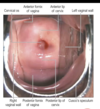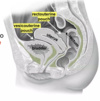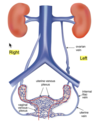Female Genetalia Flashcards
Identify the indicated features of the female genetalia
Posterior view


Identify the indicated features of the female genetalia from an superior view


What is adnexa?
The space taken up by the ovary, uterin tubes & some of the round ligament

What is the function of the uterus?
What type of organ is it?
How large is it?
serve as site for reception, retention, and nutrition of the fertilized ovum, mensuration
thick-walled, hollow muscular organ
dynamic size (~8cm * 5cm * 2cm non-pregnant adult)
Identify the indicated featues of the provided image

- uterine ostium
- receives the uterine tubes
- perimetrium
- serosal layer (thin connective tissue)
- myometrium
- thickest layer (smooth muscule, vasculature)
- contraction = period cramps
- Endmetrium
- mucous layer for uterus
- shed during menses

How could you tell if this individula has given birth?

the cirvical os is circular & would be more of a line in an individual who had previously given birth

What is the normal orientation of the uterus?
- Normal
- anteverted
- relative to vagina cervix tilts anteriorly
- anteflexed
- relative to cervix uterine body tilts anteriorly
- anteverted
- Abnormal
- retroverted
- relative to vagina, cervix tilts posteriorly
- retroflexed
- relative to cervix, uterine body tilts posteriorly
- retroverted

Identify the two indicated pouches
Why is it clinically important to know these?

Places of possible fluid accumulation

Identify the two indicated ligaments
Name their attachement points

- Transverse/Cardinal ligament
- base of the uterus, cervix, vagina to the lateral pelvic wall
- will carry uterine vessels
- Uterocervical/Sacrocervical Ligament
- attaches cervix to sacrum
- Publcervical Ligament
- from pubis to cervix

Identify the ligaments depicted in the provided image
Provide the attachment sites for each

-
Broad ligament
-
Mesometrium
- broadest section that covers the uterus
- covers external iliac vessels
-
Mesovarium
- suspends the ovaries (posterior connection), but does not wrap all the way around
-
Mesosalpinx
- covers the uterine tube
- anastamoses between uterine & ovarian vessels
-
Suspensory/infundibular
- carries ovarian artery & vein
- from the lateral abdominal wall and attaches to the lateral pole of the ovaries
-
Mesometrium
-
Ovarian ligament
- connect medial pole of ovaries to uterus
- opposite end of suspensory ligament
-
Round ligament of the uterus
- connects the uerine cornu to labia majora after passing through inguinal canal
-
Cardinal
- connects cervix and lateral pelvic wall
- contains uterine vessels
-
Uterosacral
- connects cervix and sacrum
-
Pubocervical (not shown)
- connected cervix and posterior pubic symphysis

What is a uterine prolapse & what are the most common causes?
outward displacement of the uterus via the vagina
- Ligaments weakening
- levator ani
- uterosacral ligament
- child birth
- downward displacement
- menopause
- vagina

Identify the arterys that supply the female genetalia
name each stucture supplied by each artery
name where each artery arises from

-
ovarian artery (from abdominal aorta)
- ovaries
- tube
- uterus
-
uterine (from internal iliac)
- uterus
- tube (small amount)
- vagina
-
Vaginal artery (from internal pudendal)
- vagina

What the relationship between the ureters and uterine arteries?
Why is this important?
ureters lie inferior to the uterine arteries
(water under the bridge)
If someone is trying to take the uterus out, and instead of ligating the uterine, they ligate the ureter. So, knowing this anatomical spatial relationship is key
What is a hysterectomy & what are some reasons a person may have one?
What are the 2 approaches to this surgery?
surgical removal of the uterus
- Causes
- cancer, chronic pain, chronic bleeding, endometriosis, fibroids, & uterine prolapse
- Approaches
- abdominally
- laparoscopically/transvaginal (more common now)

What is a pap test and why are they performed?
- screening for cervical cancer
- cells from the cervix are sampled using a speculum & cytobrush and sent for cytological assessment























